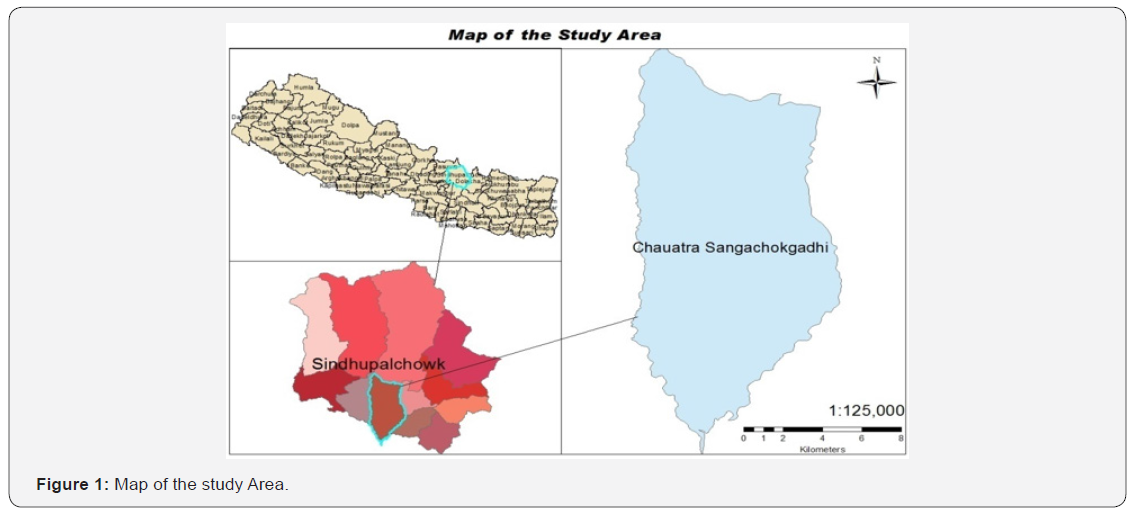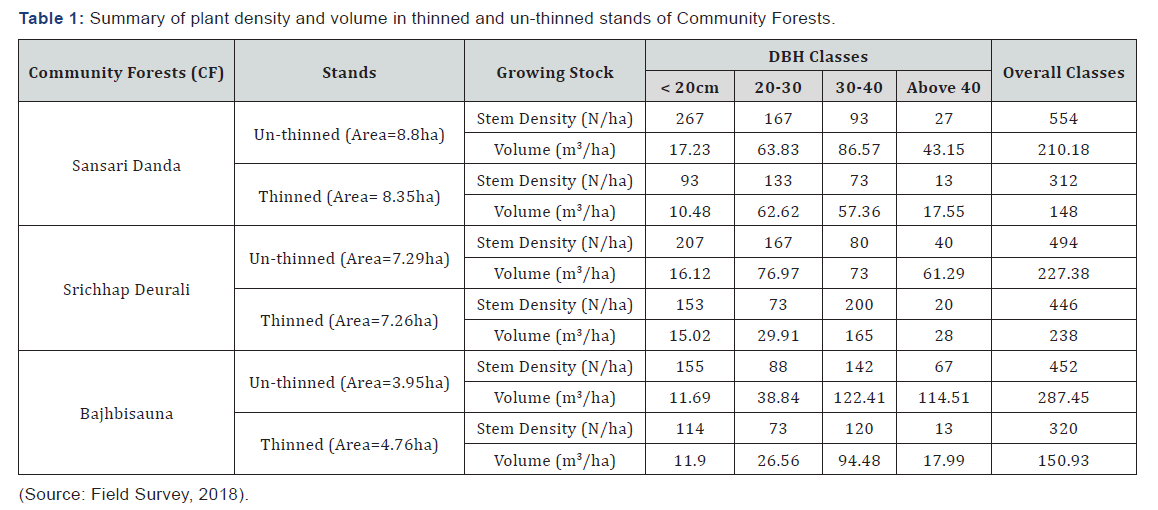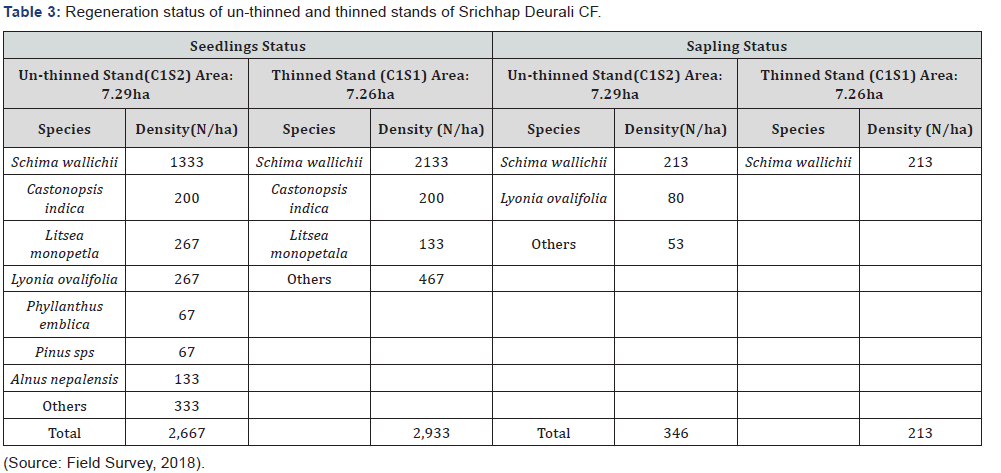Growing Stock and Regeneration Status Assessment in Thinned and Un-thinned Stands of Community Managed Pine Plantation
Benju Baniya1*, Ram Asheshwar Mandal2, Shankar Adhikari3 and Ashal Shrestha3
1Nepal Agroforestry Foundation, Nepal
2School of Environmental Science and Management, Nepal
3Ministry of Forests and Environment, Nepal
Submission: May 21, 2019; Published: June 14, 2019
*Corresponding author: Benju Baniya, Nepal Agroforestry Foundation, Kathmandu, Nepal
How to cite this article: Benju Baniya, Ram Asheshwar Mandal, Shankar Adhikari, Ashal Shrestha. Growing Stock and Regeneration Status Assessment in Thinned and Un-thinned Stands of Community Managed Pine Plantation. Int J Environ Sci Nat Res. 2019; 20(1): 556030. DOI:10.19080/IJESNR.2019.20.556030
Abstract
The forests of Nepal are experiencing new forest management practices in the recent scenario. Silvicultural treatments such as thinning have been practiced over the years; however, proper thinning according to the thinning guidelines has recently been introduced to most of the community forests in Nepal. Thus, this research was carried out to assess and compare the growing stock and regeneration status in thinned and un-thinned stands of three different community forests in Sindhupalchowk, Nepal. Moreover, the species richness was also evaluated. Total 30 circular sample plots having an area of 100m2 were established in each of the community forests to perform forest resource inventory. Statistical tests such as independent samples t-test and Mann-Whitney U test were applied for analysis and comparison of growing stock and regeneration status between thinned and un-thinned stands.
In Sansari Danda Community Forest, there were 554stems/ha in un-thinned stand which was significantly more in comparison to 312stems/ha in thinned stand. Also, the total volume of trees in un-thinned stand were 210m3/ha, however it was only 148m3/ha in the thinned stand. Although, 12,867 seedlings/ha were found in the un-thinned stand of Sansari Danda, it was less in comparison to 14,000 seedlings/ha in thinned stand of the same community forest. This research illustrates the effect of thinning on pine plantation. Therefore, it will be helpful tool for scientific community and decision makers who are involved in forest management and silviculture science.
Keywords: Thinning, growing stock; Regeneration; Community forest; Pine forest
Introduction
Forest management intends to create stability between biodiversity conservation and sustainability of livelihood [1]. These environmental and economic goals can only be achieved by the application of silvicultural treatments such as thinning. Thinning, defined as the reduction of trees in an immature stand for the purpose of improving growth and form of residual trees without permanently breaking the canopy [2], has been applied time and again to manage the dense and overstocked stands. It can also be used in attaining other objectives such as varying the species composition, disturbing an established ground flora to enhance opportunities for natural regeneration [3], reducing above and below ground plant competition among residual trees [4] and reducing fire hazard and stand mortality [5].
Thinning of the trees has observed to have great effect on the regeneration and growing stock of trees. Growing stock can be defined as the volume over bark of all living trees with a minimum diameter of 10cm at breast height [6]. According to Hunt et al. [7], there is inverse impact of stocking density (trees/ha) on the growth of the trees; and only possible way to maintain normal growing stock is sivicultural treatments like thinning. Moreover, thinning is supposed to have induced regeneration in the plantation forests. However, heavy thinning might cause immediate decrease in the understory vegetation [8] since there may have substantial ground disturbances during thinning operation [9]. If the aim of management is to gradually convert into broadleaved forest, coniferous are thinned out to promote the broadleaves [10].
Pine plantation holds a three-decade long history in the mid- hills of Nepal namely in Sindhupalchowk and Kavrepalanchowk district. Forestry in Nepal has been circumscribed to protection, plantation and to some extent thinning, pruning, fodder and grass cutting [11,12]. However, recently some silvicultural operations are being implemented to manage those planted pine forests. The pine forest is generally established in the degraded soil which makes regeneration a challenging issue [13]. The seeds germinate under moderately dense canopy and mortality of seedlings is high in open canopy as well. Nevertheless, reduction in the canopy density of mature stands promotes seedling growth [14]. Moreover, in the past the forests were found to be overstocked due to the lack of silvicultural operations like thinning itself. In this context, this research assesses growing stock and regeneration status in newly thinned stands and compare the same parameters with un-thinned stands in order to address the effect of thinning.
Materials and Methods
Study area


Sindhupalchowk, a part of Province No. 3, has total forest area of 77567ha. There are in total 518 community forest user groups and the total land occupied by community forest is 29,056ha in which pine plantation is the most prevalent (13,000ha). Three community forests (CF) namely, Sansari Danda, Srichhap and Bajhbisauna were taken as study site. In all three community forests, pine species like Pinus roxburghi and Pinus patula are dominant. The poles of Schimawallichii are prevalent in all three community forests. Other tree species like Rhododendron arboreum, Lyonia ovalifolia and Myrica esculenta are also established (Figure 1 & 2).
Sampling process
The digital map of the study area was extracted from GIS. The already stratified thinned and un-thinned stands having equivalent areas were chosen from operational plan of Community Forests. After that, the number of sample plots was allocated using Geographical Information System. Altogether, 90 samples were collected from three CFs. Moreover, 15 circular plots were established in each thinned and un-thinned stand of three community forests. The sample plot size for trees and poles was taken as 100m2 with radius of 5.64m, for saplings 25m2 with radius of 2.82m and for seedlings 10m2 with radius 1.78m.
Measurement and recording
For the calculation of growing stock, diameter at breast height (DBH) and height were directly measured using diameter tape and range finder respectively. Moreover, the numbers of stems (DBH>10cm) in each plot were counted. For the regeneration assessment, all the species in regeneration layer were counted.
Data analysis
Growing stock includes basal area, volume and stem densities which were calculated using following forest mensuration formula:
a) Basal Area (BA)= DBH2*π/4
b) Volume= Basal area*height*form factor
c) Stem Density= No. of stems (DBH>10cm)/Area(ha)
Parametric test such as Independent-samples t-test and nonparametric test such as Mann- Whitney U test was performed to analyze data.
Results
The results of the findings indicate that stem density, volume and regeneration status varied in thinned and un-thinned stands of different community forests.
Comparison of growing stock (stem density and volume) in thinned and un-thinned stands of community forests
The result in Sansari Danda community forest shows that the stem density was more in un-thinned stand i.e. 554 stems/ha than the thinned one i.e. 312 stems/ha. Moreover, the application of Independent samples t-test showed that there was significant difference (P=0.001) in overall stem density in thinned and un-thinned stands at 5% level of significance. Similarly, the total volume of trees and poles were greater in un-thinned stands (210.8m3/ha) in comparison to thinned one (148m3/ ha). However, the application of Mann-Whitney U test showed that the overall volume per hectare did not differ significantly (P=0.443) at 5% level significance in between thinned and unthinned stands of Sansari Danda Community Forest.
In Srichhap Deurali Community Forest, the total stem density was found to be more in un-thinned stand i.e. 494stems/ ha in comparison to thinned stand i.e. 446stems/ha which were not significant (P=0.513) statistically. The volume occupied by trees and poles in thinned stand was 238m3/ha which was greater in comparison to volume occupied by trees and poles in un-thinned stand i.e. 227.38m3/ha without any significant differences (P=0.694).
In Bajhbisauna community forest, the result depicts that the total stem density was found to be higher in un-thinned stand i.e. 452stems/ha than the thinned stand i.e. 320stems/ ha of Bajhbisauna CF. The application of Mann-Whitney U test showed that there were significant differences (P=0.016) in overall stem density at 5% level of significance between thinned and un-thinned stands of pine forest. The volume occupied by plants was maximum in un-thinned stands (287.45m3/ha) in comparison with the thinned stands (150.93m3/ha) which was statistically insignificant (P=0.23) (Table 1).

In Sansari Danda Community forest, it was found that the number of seedlings per ha in the un-thinned stand were 12,867, lesser than the seedlings per hectare in thinned stand i.e. 14,000 (Table 2). The statistical analysis shows that there was no significant difference (P=0.819) in number of seedlings at 5% level of significance between thinned and un-thinned stands as they differ by very few margins. Similarly, the number of saplings per hectare was also found to be more in thinned stand i.e. 773 saplings/ha whilst it was found to be 294 saplings/hectare in un-thinned stands which were significantly different (P=0.003).

In Srichhap community forest, the result shows that the number of seedlings per hectare in the un-thinned stand of Srichhap Community Forest was 2,667 while the number of seedlings per hectare in thinned stand was 2,933. It further concludes that thinning is having positive impact on the forest regeneration. On the other hand, the statistical analysis shows that there was no significant difference in seedling status (P=0.533) between thinned and un-thinned stands. The number of saplings was found to be more in un-thinned stand i.e. 346saplings/ha whilst it was found to be 213 saplings/ hectare in thinned stand; the result was statistically insignificant (P=0.147) (Table 3).

In Bajhbisauna community forest, the number of seedlings/ ha in the un-thinned stand was 8,200 which is less than the seedlings/ha in thinned stand i.e. 9,800 with no significant difference (P=0.720) at 5% level of significance. The number of saplings per hectare was found to be more in un-thinned stand i.e. 533saplings/ha while it was found to be 160saplings/ha in thinned stand with no significant difference (P=0.07) at 5% level of significance (Table 4).

Discussion
Variation in growing stock of thinned and un-thinned stands of pine plantation
From the study carried out in three community forest, the result illustrates that the stem density was higher in the un-thinned stands of all three CFs than thinned stands and statistically significant as well. These results of this report regarding stem densities of stands are in line with the previous results. In a study carried out by Lin et al. [15], the stand densities for each stand after thinning in the same year decreased significantly for both medium and heavy thinning. Moreover, L.S. Khanna in his book Principles and Practices of Silviculture, 2011, has rightly mentioned that thinning reduces the number of trees, which this study justifies. The result is similar in study carried out by Harrod et al. [16] to examine the response of thinning to insect outbreaks where thinning modified the forest structure by reducing the overall stocking by less than fifty percent. The average stocking density in the un-thinned stands of planted pine forest was medium (500stems/ha) while it was 360trees/ ha (medium) in thinned stands as per [17].
Moreover, the volume per hectare was found to be more in unthinned stands in two of the community forests (Sansari Danda and Bajhbisauna) but not in the third (Srichhap). In Srichhap, the volume per hectare was found to be more in un-thinned stand most probably due to presence of maximum number of trees having good height and DBH 30-40cm with volume 165m3/ ha. However, there were no significant differences in volume per hectare in any of the community forest sampled. According to thinning hypothesis, thinning does not affect the volume growth of stands significantly for a wide range of stocking densities [18]. The effect of thinning on volume of stand is strongly site dependent but heavy thinning usually reduces in growth of volume growth in comparison to un-thinned stands growing on similar site conditions [19], the result being like this research.
Variation in regeneration status of thinned and unthinned stands of pine plantation
The report on Douglas- Fir clearly indicates that average seedling density was significantly higher in thinned stands (1433/ha) than the un-thinned stands (233/ha) [20]. However, in this research, the numbers of seedlings were not significantly different in any of the CFs-- the main reason assumed being time factor. The Douglas-Fir report was published on 1998 whereas the thinning was done in 1969-1984, at least after 10-24 years, which clearly indicates that for the proper result regarding the effects of thinning, time factor is essential. Similarly, the numbers of saplings were found to be significantly different in only one Community forest (Sansari Danda) and not in other two.
Utsugi et al. [21] noted that thinning creates species diversity in conifer plantation sooner and with more consistency. However, in this research more species richness was seen in unthinned stands. The result also indicates that many broadleaved species like Schima wallichii, Endosperma chanensis, Myrica esculenta, Castonopsis indica and Rhododendron arboreum were emerging in the planted forest. In a research carried out by Thomas et al. [22], thinning was found out to be an effective option to create species diversity in the regeneration layer. In this study, the seedlings and saplings of Schima wallichii were in maximum number in the thinned stands which might be the effect of thinning.
Conclusion
The study shows that the stem density is significantly higher in the un-thinned stands of community forests that the thinned one. Moreover, the Schima wallichii’s stem density was more prevalent in DBH class 10-20cm which illustrates that the forest is progressively changing into broad leaved. The volume of trees and poles are also found to be more in unthinned stands. Similarly, the number of seedlings per hectare is more in thinned stands, the statistical difference being insignificant. The numbers of saplings are more in un-thinned stands; nevertheless, they are not significantly different. The most widespread sapling found in all three community forests is Schima wallichii followed by Pinus species. Moreover, there is more species richness in the un-thinned stands. More researches should be carried out every year to represent the annual effect of thinning as most of the results are not significant at present. Similarly, it is recommended that thinning should be carried out annually in different compartments to promote regeneration as well as to maintain normal growing stock.
Acknowledgement
We would like to acknowledge Kathmandu Forestry College team for their tremendous support during this research. We are also thankful to Silviculture Division, Department of forest, Kathmandu, Nepal for supporting this research financially as well as intellectually.
References
- Food and Agricultural Organization (FAO) (2002) Convention on Biological Diversity.
- Khanna LS (2011) Principles and practices of Silviculture. Dehradun, India
- Kerr G, Haufe J (2011) Thinning Practice: A Silvicultural Guide. Forestry Commission, pp. 1-54.
- Smith DM, Larson BC, Ketly MJ, Ashton MS (1997) The practice of Silviculture: Applied Forest Ecology. Wiley, New York, USA.
- Ritchie MW, Skinner CN, Hamilton TA (2007) Probability of tree survival after wildfire in an interior pine forest of northern California: Effects of thinning and prescribed fire. Forest Ecology and Management 247(1-3): 200-208.
- FAO FRA (2012) Forest Resources Assessment 2015: Terms and Definitions. FAO Report, 36.
- Hunt S, Dangal S, Shrestha S (2001) Minimizing the cost of overstocking towards a thinning regime for community managed pine plantations.
- Beese WJ, Bryant AA (1999) Effect of alternative silvicultural systems on vegetation and bird communities in coastal montane forests of British Columbia, Canada. Forest Ecology and Management 115(2-3): 231-242.
- Charles H, Donald M (2001) Disturbance and post-harvest ground conditions in a structural retention experiment. Forest Ecology and Management 154(1/2): 215-225.
- Jackson J (1994) Manual of Afforestation in Nepal. Forest Research and Survey Centre, Ministry of Forests and Soil Conservation, Kathmandu, Nepal.
- Poudyal AS, Sapkota S (2017) Pine plantations management in Community Forest: Application of silviculture to enhance productivity, replacement of timber import and conversion into mixed forest.
- Hunt S, Dangal S, Shrestha S (2001) The Impact of Stocking on the Growth of Pine Plantations in the Mid Hills Districts of Kabhre Palanchok and Sindhu Palchok.
- Duryea ML, Dougherty PM (1990) Forest Regeneration Manual.
- Brockway G, Outcalt KW (1998) Gap-phase regeneration in long leaf pine wiregrass ecosystem. Forest Ecology and Management 106(2-3): 125-139.
- Lin JC, Chiu CM, Lin YJ, Liu WY (2018) Thinning Effects on Biomass and Carbon Stock for Young Taiwania Plantations. Scientific Reports 8(1): 1-7.
- Harrod RJ, Povak NA, Peterson DW (2007) Comparing the effectiveness of thinning and prescribed fire for modifying structure in dry coniferous forests. pp. 329-346.
- Dangal SP, Das AK (2011) Effects of management practices on growth rate of pine plantations in Nepal. Banko Janakari 25(1): 1-9.
- Skovsgaard JP, Vanclay JK (2008) Forest site productivity: A review of the evolution of dendrometric concepts for even-aged stands. Forestry 81(1): 13-31.
- Skovsgaard JP (2009) Analyzing effects of thinning on stand volume growth in relation to site conditions: A case study for even-aged Sitka spruce (Piceasitchensis (Bong.) Carr.). Forestry: An International Journal of Forest Research 82(1): 87-104.
- Bailey JD, Tappeiner JC (1998) Effects of thinning on structural development in 40-100-year-old Douglas-fir stands in western Oregon. Forest Ecology and Management 108(1-2): 99-113.
- Etsuko U, Hiroshi K, Naoto U, Mizuki T, Tomoyuki S, & et al. (2006) Hardwood recruitment into conifer plantations in Japan: Effects of thinning and distance from neighboring hardwood forests. Forest Ecology and Management 237(1-3): 15-28.
- Thomas SC, Halpern CB, Falk DA, Austin KA (1999) Plant Diversity in managed forests: understory responses to thinning and fertilization. Ecological Applications 9(3): 864-879.






























